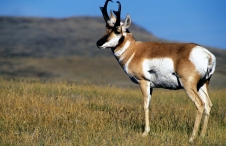Coyotes
Coyotes (Canis latrans) are medium-sized mammals that belong to the dog family (Canidae). Prior to the arrival of European people in North America, coyotes were found only in the central part of the United States and in northern Mexico. However, today coyotes are found from Alaska to Costa Rica and from coast to coast in the United States. The main reason for this population expansion is that coyotes are extremely adaptable and can become accustomed to almost any habitat type. They even have the ability to live in association with humans and can inhabit urban environments such as Las Vegas and Reno. The coyote is now one of the most successful and widely distributed predators in North America.
Coyotes vary greatly in size across their distribution. In desert areas, coyotes weigh about nine kilograms less than coyotes in the mountains and in eastern states. In Nevada, the adult coyote weighs from 10 to 12 kilograms (22 to 26 pounds) and is about 110 centimeters (3 feet, 7 inches) in length. Desert coyotes also are lighter in color, usually gray or tan, and run with their bushy tails held low. Coyotes can be active any time of day, but they are most active during the early morning and evening hours. However, in areas where they are not disturbed by human activity, they tend to be more active during the day. Young coyotes are also usually more active during the day than adults.
Coyotes demonstrate much variability in social organization. Like wolves, individual coyotes can play alpha, beta, or transient roles. The alpha pair is made up of the monogamously breeding male and female coyotes within a territory. They typically live in family groups together with the nondispersing young of the previous year or two (betas) and pups. Betas often help with raising the pups and generally do not breed themselves. Pack sizes can vary from two (the alpha pair) to twelve or more members; however, four to six individuals are most common. Coyote territories in the West tend to be exclusive, maintained year round and spaced contiguously across the landscape. In contrast, transient coyotes do not hold territories, do not breed, and usually travel alone. They typically use larger areas than alphas and betas and overlap their use with other transient and resident animals. They travel more frequently along boundaries of territories. Home range sizes can vary widely from 5 to 100 square kilometers (1.9 to 38.6 square miles). Territory size often depends on the prey availability in an area, with larger home ranges seen in areas where less prey is available.
The diet of the coyote consists mostly of rodents and carrion. However, they are extremely opportunistic animals and will also eat fruit and insects. Working in groups, they will sometimes prey on deer and pronghorn antelope fawns, as well as on domestic sheep, livestock, and poultry. The type of prey consumed can influence social organization. Coyotes tend to be more solitary in regions where prey is mainly rodents; however, when prey is larger, such as deer, large groups of coyotes form.
In Nevada, coyotes mainly breed between January and March. Their gestation period is sixty-three days long, and they generally produce one litter a year. Three to fifteen young are born in a den. More coyote pups are born when coyote densities are lower and when food is readily available. The pups disperse at about six to nine months of age and can travel distances up to 160 kilometers (100 miles). The Nevada Department of Wildlife estimates that about 250,000 to 750,000 individual coyotes are in the state.
Coyotes can be extremely useful for controlling rodent populations. However, they are also the principal predator of domestic sheep in the West. Coyotes can produce fertile hybrids with dogs called "coydogs." These individuals are often less wary of humans but can cause much damage to the livestock industry. In an attempt to find a solution to the depredation problem, a considerable amount of research has been done on control methods. Some of the most successful methods of reducing livestock losses include livestock collars, herd dogs, and shepherds, but these methods can be expensive. Less expensive alternatives include culling coyotes in problem areas. However, while most damage is caused by certain alpha individuals, random shooting and trapping generally removes mostly betas and transients. Excessive removal increases the number of pups born in litters, which increases the chances of alpha individuals turning to livestock to feed the young. The greatest success has been achieved by removing specific problem individuals and not removing animals in areas with no livestock losses. This allows coyotes that are not problems to remain in and maintain their territories.
Article Locations
Related Articles
Further Reading
None at this time.

